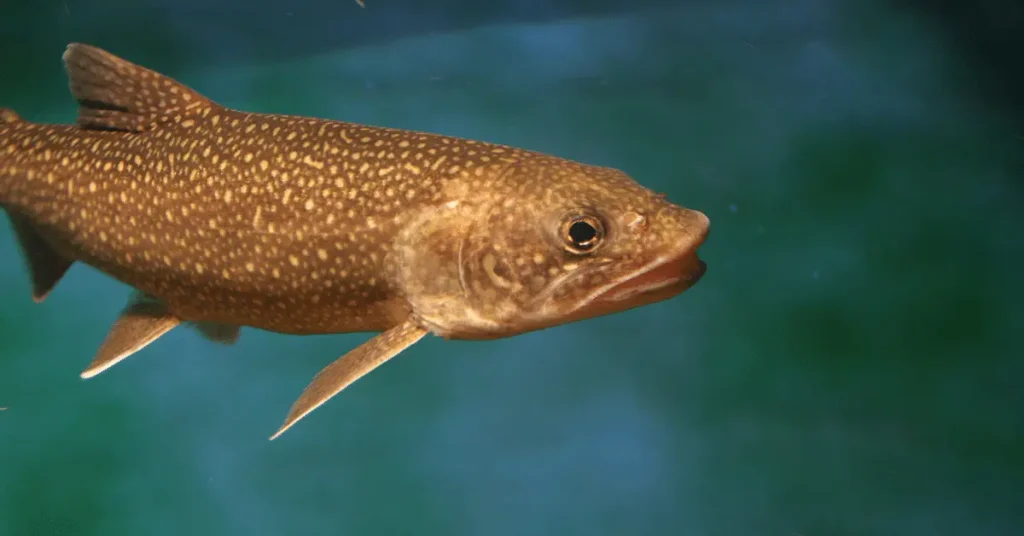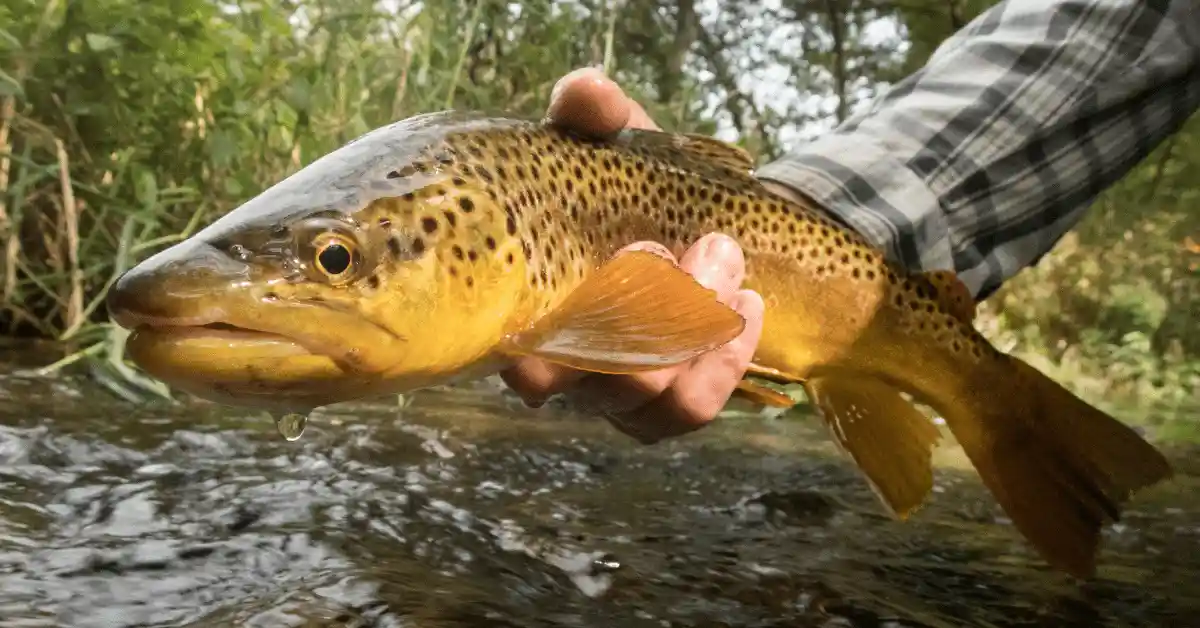The ideal test line for trout fishing depends on fishing conditions and trout size. Lighter lines (2-6 lb test) are suitable for little trout in clear water with delicate equipment, while more vital lines (8-12 lb) are better for giant trout or muddy waterways. Water clarity, trout size, and tackle weight should influence your test line choice.
You’re standing beside a clean stream, preparing to catch a dazzling trout: Rod, bait, and fortunate hat. Hold on! Fishing line? It’s not the most attractive element of your gear, but it might be the difference between a successful catch and a tale of the one that got away.

Our tutorial, Ideal Test Line for Trout Fishing, covers fishing lines in depth. We’ll unravel monofilament, explain braided cables, and even try fluorocarbon. We know how to make your next trout fishing trip successful, whether you’re a pro or a beginner.
Don’t lose your catch to a line mistake. Read on for an exciting introduction to trout fishing lines. It’s more exciting than it sounds!
Key Takeaway:
- Choose a pound test line in the range of 4-8 lbs for trout fishing.
- Line choice depends on Trout size, fishing conditions, and preference.
- Line selection balances strength and sensitivity.
- A good pound-test line improves trout’s catches.
- Line selection improves trout fishing.
Mono, Fluoro, or Braid: Which Line is Right for You?
Your success when trout fishing depends heavily on the line you use. Popular fishing line types include monofilament, fluorocarbon, and braid. Three most common varieties. Everyone is unique and valuable in their way. Topwater lures benefit significantly from the monofilament’s elasticity and buoyancy. Because of its low visibility and ability to sink, fluorocarbon is an excellent choice for fishing in deeper waters. Braided lines are ideal for fishing in dense cover due to their outstanding durability and strength-to-diameter ratio. Knowing the characteristics of several fishing lines will allow you to choose the best one for the circumstances and methods you plan to use.
Trout Line Weight Importance
High-Pound Test Cons
When fishing for trout, using lines with a high pound test might have certain downsides, even though these lines are tough and long-lasting. To begin, fish have a better chance of seeing them, which increases the likelihood that cautious trout would avoid biting. In addition, the lack of flexibility in these lines might cause the bait or lure to be presented in a less natural manner, which may cause your odds of making an excellent catch to decrease.
Light-Pound Test Limits
On the other hand, light-pound test lines, although fish are less likely to see them and that they provide a more natural presentation, may still offer difficulties. When multiple fish attack or during a struggle, they are more likely to break, and this risk is increased when the cover is dense. They may also be unable to throw as far or as accurately as lines of more substantial material.
4-Pound Test Advantages
When fishing for trout, a line with a test strength of 4 pounds will typically give a nice balance. It is light enough that fish will see it less, and its lack of visibility will allow for a more natural presentation of the bait or lure. At the same time, it is robust enough to deal with trout that are of an average size. However, it is essential to modify the weight of your line depending on the particular circumstances you will be fishing in and the size of the trout that you will be pursuing.
Trout Fishing Line Types
Many anglers enjoy the sport of trout fishing as a leisure, and the kind of fishing line that is used may have a significant influence on how successful a fishing trip is. When it comes to fishing for trout, monofilament, fluorocarbon, and braided lines, each have its own set of benefits and drawbacks that you should be aware of.
Monofilament Lines
When fishing for trout, monofilament lines are a tried-and-true favorite among many anglers, even though these lines come with their set of benefits and drawbacks.
Trout Mono Pros
Because of its adaptability and user-friendliness, monofilament lines are often considered an excellent option for novice anglers. They are also quite visible above the water, which is something that might be helpful when you are trying to monitor your line. The high stretch factor of monofilament lines gives some measure of shock absorption, which might be beneficial while battling trout because of the elevated stretch factor’s ability to stretch.
Trout Mono Cons
Monofilament line does have certain negatives in addition to its many benefits, though. Because of its excellent visibility, trout that are swimming in clear water may be able to see the line that you are using to fish with. In addition, monofilament lines have the propensity to absorb water, which over time, may result in a reduction in the lines’ strength and sensitivity.
Fluorocarbon Lines
One more common option for trout fishing is fluorocarbon lines, which have advantages and disadvantages. Fluorocarbon lines are pretty popular.
Trout Fluoro Pros
Because fluorocarbon lines are so close to being invisible underwater, they are an ideal option for fishing in areas that are notorious for having trout that are very cautious. They also have a greater density than monofilament lines, which enables them to sink quicker and reach deeper water depths where trout may be hiding. This is another advantage that these lines have over monofilament lines. In addition, fluorocarbon lines do not take in any moisture, which allows them to keep their strength and sensitivity even after being used for lengthy periods.
Trout Fluoro Cons
Fluorocarbon lines, on the other hand, are more difficult to manipulate due to their increased rigidity and less flexibility in comparison to monofilament lines. In contrast to several different kinds of fishing lines, they are often more costly.
Braided Lines
Braided lines are a relatively recent breakthrough in fishing line technology. Although they do provide some distinct benefits and drawbacks for trout fishing, they were not available until fairly recently.
Trout Braid Pros
Braided lines are well-known for having a high strength-to-diameter ratio, which enables fishermen to utilize thinner lines without compromising the lines’ ability to hold fish. When fishing for giant trout, this might be a beneficial strategy. Anglers can detect even the tiniest bites using braided lines because of the great degree of sensitivity provided by these lines.
Trout Braid Cons
On the other hand, braided lines are pretty easy to see in the water, which may be an issue when fishing for cautious trout in waterways that are very clear. They also do not flex as monofilament lines do, which might make it more difficult to battle a trout when you are using one of these lines. Finally, compared to other forms of lines, braided lines are more likely to get tangled up in the wind.
Trout Line: Top Picks
Clear Water Trout Line
Because of their acute vision, trout may be a difficult catch when fishing in waters with a high level of transparency. In these situations, a fine line with poor visibility is vital. Fluorocarbon lines, such as Seaguar Tatsu, are often the ideal option since their refractive index is quite similar to that of water. As a result, fluorocarbon lines are almost undetectable when used in water.
Murky Trout Line
When fishing in water that is cloudy or turbid, the visibility of the line becomes less of a problem. In this situation, you may want to go with a line that is more abrasion-resistant and long-lasting. Braided lines, such as Sufix Nanobraid, are a fantastic option because of their strength and sensitivity. Braided lines, like Sufix Nanobraid, enable you to detect minor bites even in water that is not as clear.
Spinner & Spoon Lines
When casting spinners and spoons, you need a line that is strong enough to carry the weight of the lures and is sensitive enough to efficiently communicate their motion. The perfect line has a modest stretch and is relatively narrow. Because of their thin diameter and great strength, braided lines are often considered the best option. This results in longer throws and improved lure action.
Top Lines for Still Trout
When fishing for trout in still water or with bait, using a line that has some stretch to it might be helpful since it can absorb the first hit and prevent the hook from being ripped out of the trout’s mouth. Because of its elasticity and adaptability, a high-quality monofilament fishing line, such as Trilene XL, is often an excellent option.
Trout Trolling Line
You need a line that can resist the frequent movement and the possible abrasion from the underwater structures while trolling for trout. The perfect line would have a little stretch and be long-lasting. Because of their superior strength and sensitivity, braided lines are often chosen as the best option for fishing lines. With braided lines, you can feel even the slightest bite.
Trout Ice Line
Ice fishing has its own unique set of difficulties, such as fishing in freezing conditions and avoiding jagged ice edges that might cut your line. It is essential to have a line that does not lose its flexibility even when exposed to cold circumstances and has high resilience to abrasion. For fishing in situations that are often clear, fluorocarbon lines are frequently a suitable option because of their endurance and low visibility, both of which are advantageous for fishing through the ice.
For more detailed tips on trout fishing, including effective techniques and bait options, be sure to check out our comprehensive guide on how to easily catch trout from shore. It provides valuable insights to help you make the most of your trout fishing adventures.
Ideal Test Line for Trout Fishing (Conclusion)
Choosing the right pound test line for trout fishing is essential for a productive and satisfying day. Trout size, fishing circumstances, and individual preference are just a few of the criteria that might help anglers pick the best choice for them. Most experts agree that lines with a test strength of between 4 and 8 pounds provide the best compromise between brute force and subtlety.
Remember that there is no “right” way to fish, so don’t be afraid to try new techniques and adjust the kind of line you use accordingly. If you have the correct sequence, you may go on thrilling trout fishing experiences and reel in remarkable catches.
F.A.Qs
Is a 12 Ib Test Good For Trout?
Depending on the trout size and circumstances, a 12 lb test line may work for trout fishing. It can handle moderate-sized trout in diverse situations. However, lighter lines may be better for smaller trout or fishing in clear, low-visibility waterways.
What Line Do I Need For Trout?
Use a 4-8 lb monofilament or fluorocarbon line for trout fishing. These lines are strong, sensitive, and controllable for trout fishing. Line selection may depend on trout size and fishing circumstances.
What Size Weight Should I Use For Trout?
The velocity, water depth, and targeted trout fishing depth determine the weight you employ. For trout fishing, 1/8 to 1/4 ounce weights are an excellent starting point. To acquire the appropriate depth and appearance, adjust the weight size.
What Size Hook And Line For Trout?
Trout hook sizes are usually between #8 and #14. The hook size varies on the trout species, bait or lure, and presentation. Match the hook size to the fish size and line strength.
What Pound Test Line For Trout Fishing?
For trout fishing, a 4-8 lb line is utilized. Manage different-sized trout, and this range balances strength and sensitivity. The pound test line selected depends on trout size and fishing circumstances.











